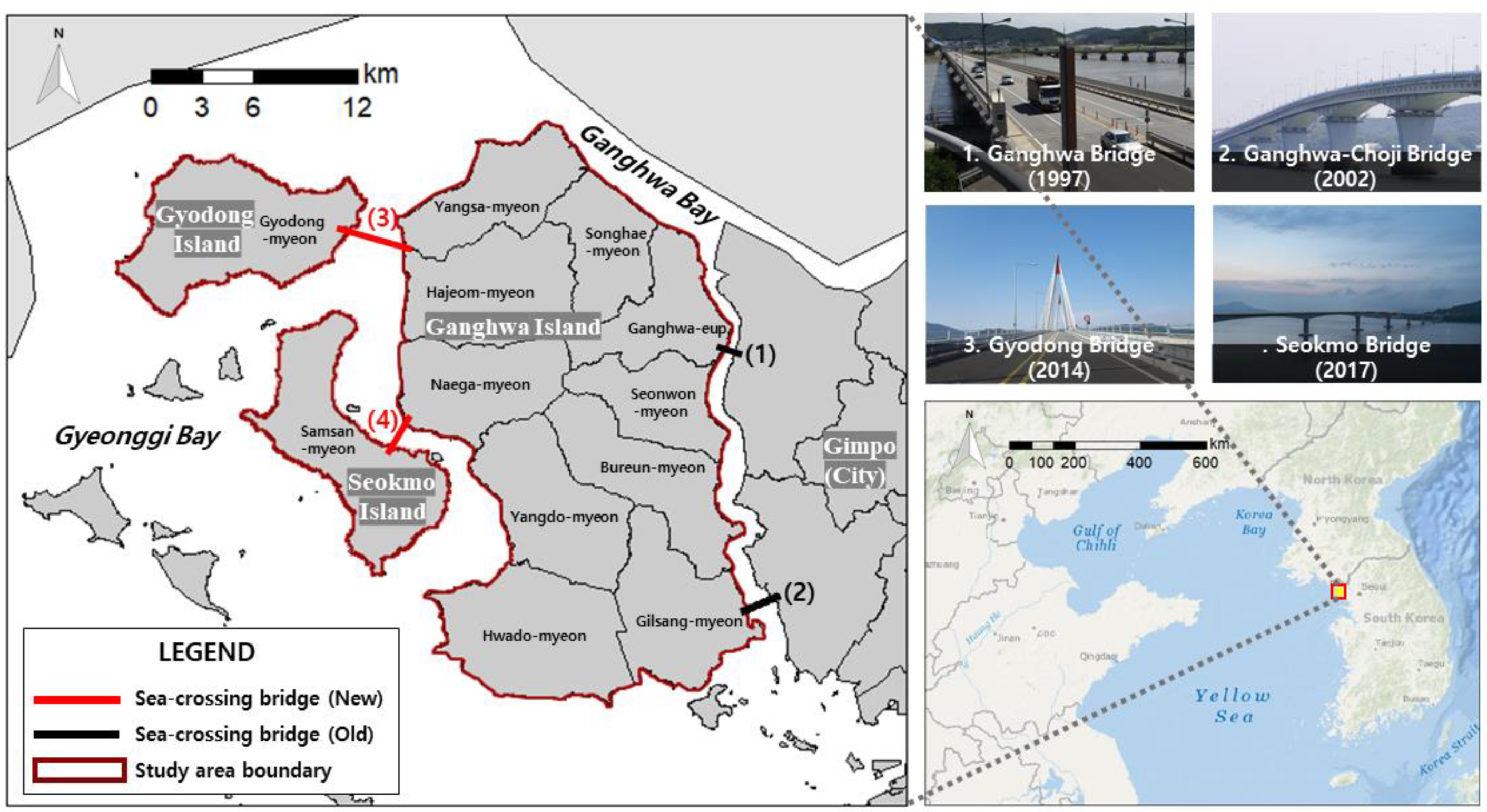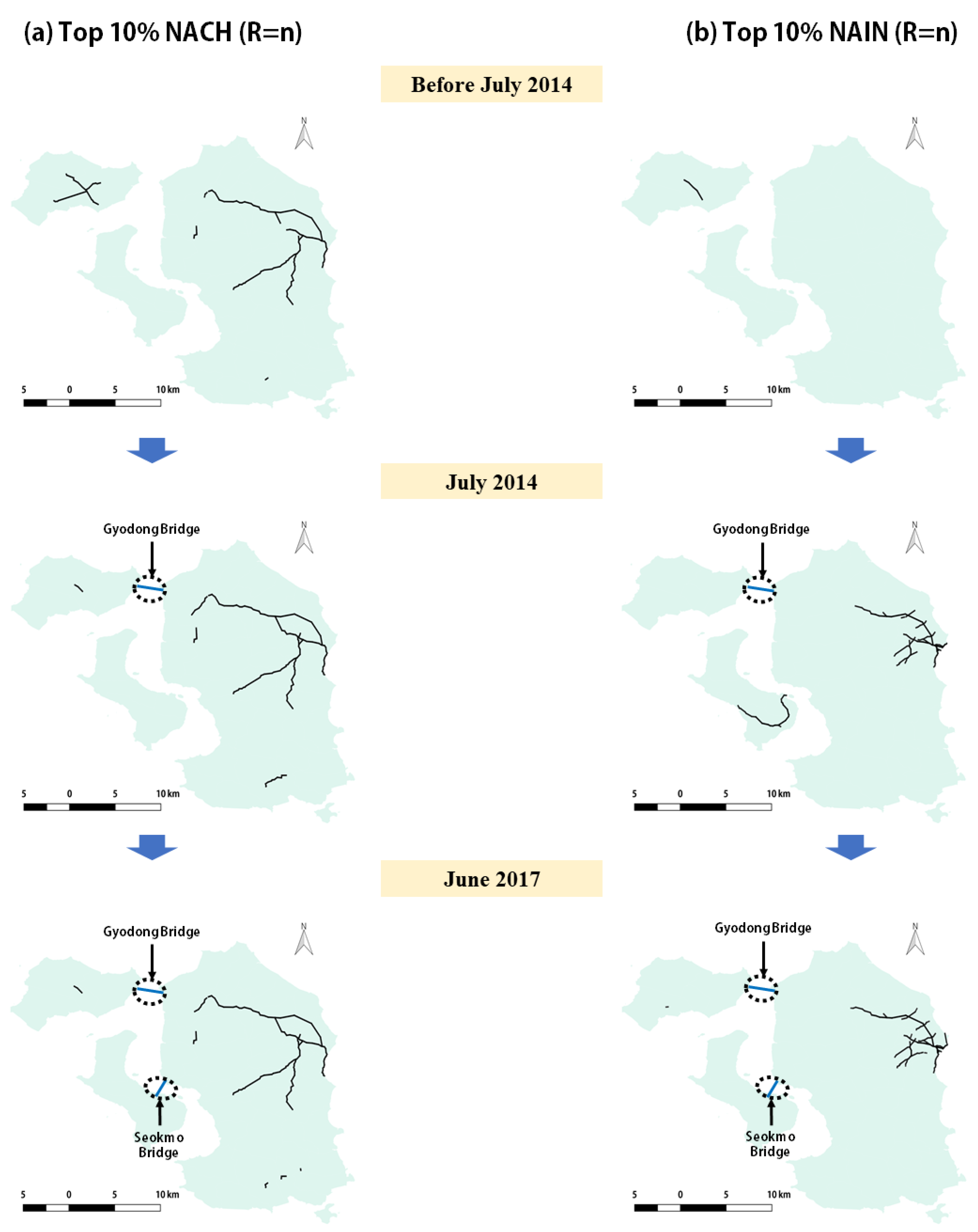Impact of Spatial Change on Tourism by Bridge Connections between Islands: A Case Study of Ganghwa County in South Korea
Abstract
1. Introduction
2. Materials and Methods
2.1. Study Area
2.2. Research Questions and Analytical Framework
2.3. Space Syntax Analysis
3. Results
3.1. Analysis of the Spatial Centrality before and after Bridge Connection on a Global Scale
3.2. Analysis of the Spatial Centrality before and after Bridge Connections at Different Radii
3.3. Correlation Analysis among Spatial Centrality, Traffic Volume and Small Accommodations
3.4. Analysis of the Core Areas after Bridge Connections between Islands
4. Discussion
4.1. Understanding the Impact of Spatial Change by Bridge Connections between Islands
4.2. Understanding Spatial Networks of Ganghwa County at Different Scales
4.3. Verifying the Relationships among Spatial Centrality, Traffic Volume and Small Accommodations
4.4. Sustainable Tourism Strategies for Islands Connected by Bridges
5. Conclusions
Author Contributions
Funding
Conflicts of Interest
References
- Baldacchino, G. The lure of the island: A spatial analysis of power relations. J. Mar. Isl. Cult. 2012, 1, 55–62. [Google Scholar] [CrossRef]
- Pan, Y.; Zhai, M.; Lin, L.; Lin, Y.; Cai, J.; Deng, J.-S.; Wang, K. Characterizing the spatiotemporal evolutions and impact of rapid urbanization on island sustainable development. Habitat Int. 2016, 53, 215–227. [Google Scholar] [CrossRef]
- Tzanopoulos, J.; Vogiatzakis, I.N. Processes and patterns of landscape change on a small Aegean island: The case of Sifnos, Greece. Landsc. Urban Plan. 2011, 99, 58–64. [Google Scholar] [CrossRef]
- Patarasuk, R.; Binford, M.W. Longitudinal analysis of the road network development and land-cover change in Lop Buri province, Thailand, 1989–2006. Appl. Geogr. 2012, 32, 228–239. [Google Scholar] [CrossRef]
- Xie, Z.; Li, X.; Zhang, Y.; Chen, S. Accelerated expansion of built-up area after bridge connection with mainland: A case study of Zhujiajian Island. Ocean Coast. Manag. 2018, 152, 62–69. [Google Scholar] [CrossRef]
- Chen, J.; Ye, G.; Jing, C.; Wu, J.; Ma, P. Ecological footprint analysis on tourism carrying capacity at the Zhoushan Archipelago, China. Asia Pac. J. Tour. Res. 2017, 22, 1049–1062. [Google Scholar] [CrossRef]
- Sun, B.; Ma, X.; de Jong, M.; Bao, X. Assessment on Island Ecological Vulnerability to Urbanization: A Tale of Chongming Island, China. Sustainability 2019, 11, 2536. [Google Scholar] [CrossRef]
- Baldacchino, G.; MacDonald, E.; Spears, A. Bridging Islands: The Impact of Fixed Links; Acorn Press: Charlottetown, PE, Canada, 2007. [Google Scholar]
- Yang, J.; Ge, Y.; Ge, Q.; Xi, J.; Li, X. Determinants of island tourism development: The example of Dachangshan Island. Tour. Manag. 2016, 55, 261–271. [Google Scholar] [CrossRef]
- Baldacchino, G. Fixed links and the engagement of islandness: Reviewing the impact of the Confederation Bridge. Can. Geogr. 2007, 51, 323–336. [Google Scholar] [CrossRef]
- Mai, T.; Smith, C. Addressing the threats to tourism sustainability using systems thinking: A case study of Cat Ba Island, Vietnam. J. Sustain. Tour. 2015, 23, 1504–1528. [Google Scholar] [CrossRef]
- Rodríguez, J.R.O.; Parra-López, E.; Yanes-Estévez, V. The sustainability of island destinations: Tourism area life cycle and teleological perspectives. The case of Tenerife. Tour. Manag. 2008, 29, 53–65. [Google Scholar] [CrossRef]
- Baldacchino, G.; Spears, A. The Bridge Effect: A Tentative Score Sheet for Prince Edward Island; Acorn Press: Charlottetown, PE, Canada, 2007. [Google Scholar]
- Evans, D.; Eng, P.; Thompson, B. ENVIRONMENTAL MANAGEMENT OF AGED BRIDGE STRUCTURES IN PEI. In Proceedings of the Transportation Factor 2003, Annual Conference and Exhibition of the Transportation Association of Canada (Congres et Exposition Annuels de l’Association des Transport du Canada), St. John’s, NL, Canada, 21–24 September 2003. [Google Scholar]
- McQuaid, R.W.; Greig, M. The bridge to Skye, Scotland. In Bridging Islands: The Impact of Fixed Links; Acorn Press: Charlottetown, PE, Canada, 2007; pp. 189–206. [Google Scholar]
- Cottrell, J.R.; Cottrell, S.P. Sense of place predictors of perceived effects of a proposed island to mainland bridge on future experience. Isl. Stud. J. 2019, 14, 187–204. [Google Scholar]
- McElroy, J.L. A world of islands: An island studies reader. Geogr. Rev. 2007, 97, 304–306. [Google Scholar]
- Li, Y.; Xiao, L.; Ye, Y.; Xu, W.; Law, A. Understanding tourist space at a historic site through space syntax analysis: The case of Gulangyu, China. Tour. Manag. 2016, 52, 30–43. [Google Scholar] [CrossRef]
- Karimi, K. A configurational approach to analytical urban design: ‘Space syntax’ methodology. Urban Des. Int. 2012, 17, 297–318. [Google Scholar] [CrossRef]
- Bafna, S. Space syntax: A brief introduction to its logic and analytical techniques. Environ. Behav. 2003, 35, 17–29. [Google Scholar] [CrossRef]
- Hillier, B.; Hanson, J. The Social Logic of Space; Cambridge University Press: Cambridge, UK; London, UK, 1989. [Google Scholar]
- Ganghwa County Basic Statistics 2018. Available online: http://www.ganghwa.go.kr/open_content/main/bbs/bbsMsgFileDown.do?bcd=datastats&msg_seq=13&fileno=3 (accessed on 14 June 2019).
- Traffic Monitoring System. Available online: http://www.road.re.kr/itms/itms_01_1.asp (accessed on 1 July 2019).
- Homestay Statistics in Ganghwa County 2017. Available online: https://www.ganghwa.go.kr/open_content/main/bbs/bbsMsgFileDown.do?bcd=opendata&msg_seq=2091&fileno=1 (accessed on 12 September 2019).
- Homestay Statistics in Ganghwa County 2019. Available online: https://www.ganghwa.go.kr/open_content/main/bbs/bbsMsgFileDown.do?bcd=opendata&msg_seq=3412&fileno=1 (accessed on 12 September 2019).
- Hillier, B.; Penn, A.; Hanson, J.; Grajewski, T.; Xu, J. Natural movement: Or, configuration and attraction in urban pedestrian movement. Environ. Plan. B Plan. Des. 1993, 20, 29–66. [Google Scholar] [CrossRef]
- Penn, A.; Hillier, B.; Banister, D.; Xu, J. Configurational modelling of urban movement networks. Environ. Plan. B Plan. Des. 1998, 25, 59–84. [Google Scholar] [CrossRef]
- Baum, J.A.; Haveman, H.A. Love thy neighbor? Differentiation and agglomeration in the Manhattan hotel industry, 1898–1990. Adm. Sci. Q. 1997, 42, 304–338. [Google Scholar] [CrossRef]
- Chung, W.; Kalnins, A. Agglomeration effects and performance: A test of the Texas lodging industry. Strateg. Manag. J. 2001, 22, 969–988. [Google Scholar] [CrossRef]
- Choi, Y.; Song, K.; Kim, M.; Lee, J. Transformation planning for resilient wildlife habitats in ecotourism systems. Sustainability 2017, 9, 487. [Google Scholar] [CrossRef]
- Klarqvist, B. A space syntax glossary. Nordisk Arkitekturforskning 1993, 2, 11–12. [Google Scholar]
- Hillier, B.; Iida, S. Network and psychological effects in urban movement. In Proceedings of the International Conference on Spatial Information Theory, Heidelberg/Berlin, Germany, 14–18 September 2005; pp. 475–490. [Google Scholar]
- Hillier, W.; Yang, T.; Turner, A. Normalising least angle choice in Depthmap-and how it opens up new perspectives on the global and local analysis of city space. J. Space Syntax 2012, 3, 155–193. [Google Scholar]
- Jiang, B.; Liu, C. Street-based topological representations and analyses for predicting traffic flow in GIS. Int. J. Geogr. Inf. Sci. 2009, 23, 1119–1137. [Google Scholar] [CrossRef]
- Omer, I.; Jiang, B. Can cognitive inferences be made from aggregate traffic flow data? Comput. Environ. Urban Syst. 2015, 54, 219–229. [Google Scholar] [CrossRef]
- Pont, M.B.; Marcus, L. What can typology explain that configuration cannot. In Proceedings of the SSS10 10th International Space Syntax Symposium, London, UK, 13–17 July 2015. [Google Scholar]
- Hillier, B. Cities as movement economies. Urban Des. Int. 1996, 1, 41–60. [Google Scholar] [CrossRef]
- Knowles, R. 12 Fixed Links and Short Sea Crossings. In Cityports, Coastal Zones and Regional Change: International Perspectives on Planning and Management; Wiley: Hoboken, NJ, USA, 1996; p. 213. [Google Scholar]
- Matthiessen, C.W. The Öresund Area: Pre-and post-bridge cross-border functional integration: The bi-national regional question. GeoJournal 2004, 61, 31–39. [Google Scholar] [CrossRef]
- Turner, A. From axial to road-centre lines: A new representation for space syntax and a new model of route choice for transport network analysis. Environ. Plan. B Plan. Des. 2007, 34, 539–555. [Google Scholar] [CrossRef]
- Yue, W.; Qiu, S.; Zhang, H.; Qi, J. Migratory patterns and population redistribution in China’s Zhoushan Archipelago in the context of rapid urbanization. Isl. Stud. J. 2017, 12. [Google Scholar] [CrossRef]
- Serra, M.; Hillier, B. Spatial configuration and vehicular movement. In Proceedings of the 11th Space Syntax Symposium, Lisbon, Portugal, 3–7 July 2017. [Google Scholar]
- Clark, E.; Johnson, K.; Lundholm, E.; Malmberg, G. Island gentrification and space wars. In A World of Islands: An Island Studies Reader; Island Studies Press: Charlottetown, PE, Canada, 2007; pp. 481–510. [Google Scholar]
- Saenz-de-Miera, O.; Rosselló, J. The responsibility of tourism in traffic congestion and hyper-congestion: A case study from Mallorca, Spain. Tour. Manag. 2012, 33, 466–479. [Google Scholar] [CrossRef]
- Cui, X.; Ryan, C. Perceptions of place, modernity and the impacts of tourism–Differences among rural and urban residents of Ankang, China: A likelihood ratio analysis. Tour. Manag. 2011, 32, 604–615. [Google Scholar] [CrossRef]
- Lue, C.-C.; Crompton, J.L.; Fesenmaier, D.R. Conceptualization of multi-destination pleasure trips. Ann. Tour. Res. 1993, 20, 289–301. [Google Scholar] [CrossRef]
- de Oliveira Santos, G.E.; Ramos, V.; Rey-Maquieira, J. Determinants of multi-destination tourism trips in Brazil. Tour. Econ. 2012, 18, 1331–1349. [Google Scholar] [CrossRef]
- Weaver, D.B. Ecotourism as mass tourism: Contradiction or reality? Cornell Hotel Restaur. Adm. Q. 2001, 42, 104–112. [Google Scholar] [CrossRef]
- Choi, Y.; Doh, M.; Park, S.; Chon, J. Transformation planning of ecotourism systems to invigorate responsible tourism. Sustainability 2017, 9, 2248. [Google Scholar] [CrossRef]







| Mean NACH (Radii) | Origin (before July 2014) | Connecting Gyodong Bridge (July 2014) | Connecting Seokmo Bridge (June 2017) |
|---|---|---|---|
| NACH (R = 500 m) | 0.4679 | 0.4681 | 0.4675 |
| NACH (R = 1000 m) | 0.8352 | 0.8347 | 0.8361 |
| NACH (R = 2000 m) | 1.0258 | 1.0252 | 1.0256 |
| NACH (R = 3000 m) | 1.0481 | 1.0481 | 1.0484 |
| NACH (R = 5000 m) | 1.0392 | 1.04 | 1.0407 |
| NACH (R = 8000 m) | 1.0148 | 1.0162 | 1.0159 |
| NACH (R = 12,000 m) | 0.9932 | 0.9948 | 0.9942 |
| NACH (R = n) | 0.9133 | 0.9081 | 0.9122 |
| Mean NAIN (Radii) | Origin (before July 2014) | Connecting Gyodong Bridge (July 2014) | Connecting Seokmo Bridge (June 2017) |
|---|---|---|---|
| NAIN (R = 500 m) | 1.4017 | 1.4016 | 1.4041 |
| NAIN (R = 1000 m) | 1.3959 | 1.3957 | 1.3994 |
| NAIN (R = 2000 m) | 1.1367 | 1.1366 | 1.1394 |
| NAIN (R = 3000 m) | 0.9303 | 0.9312 | 0.933 |
| NAIN (R = 5000 m) | 0.7118 | 0.7123 | 0.7134 |
| NAIN (R = 8000 m) | 0.5659 | 0.5664 | 0.5661 |
| NAIN (R = 12,000 m) | 0.479 | 0.4789 | 0.4764 |
| NAIN (R = n) | 0.32 | 0.293 | 0.2735 |
| Year | Correlation Coefficient (r) |
|---|---|
| Origin (before July 2014) | 0.427 |
| Connecting Gyodong Bridge (July 2014) | 0.980 * |
| Connecting Seokmo Bridge (June 2017) | 0.955 * |
| Year | Correlation Coefficient (r) |
|---|---|
| Origin (before July 2014) | −0.762 * |
| Connecting Gyodong Bridge (July 2014) | 0.394 |
| Connecting Seokmo Bridge (June 2017) | 0.606 * |
© 2019 by the authors. Licensee MDPI, Basel, Switzerland. This article is an open access article distributed under the terms and conditions of the Creative Commons Attribution (CC BY) license (http://creativecommons.org/licenses/by/4.0/).
Share and Cite
Jeong, D.; Choi, Y.E.; Jin, L.; Chon, J. Impact of Spatial Change on Tourism by Bridge Connections between Islands: A Case Study of Ganghwa County in South Korea. Sustainability 2019, 11, 6516. https://doi.org/10.3390/su11226516
Jeong D, Choi YE, Jin L, Chon J. Impact of Spatial Change on Tourism by Bridge Connections between Islands: A Case Study of Ganghwa County in South Korea. Sustainability. 2019; 11(22):6516. https://doi.org/10.3390/su11226516
Chicago/Turabian StyleJeong, Daeyoung, Yun Eui Choi, Lilan Jin, and Jinhyung Chon. 2019. "Impact of Spatial Change on Tourism by Bridge Connections between Islands: A Case Study of Ganghwa County in South Korea" Sustainability 11, no. 22: 6516. https://doi.org/10.3390/su11226516
APA StyleJeong, D., Choi, Y. E., Jin, L., & Chon, J. (2019). Impact of Spatial Change on Tourism by Bridge Connections between Islands: A Case Study of Ganghwa County in South Korea. Sustainability, 11(22), 6516. https://doi.org/10.3390/su11226516





